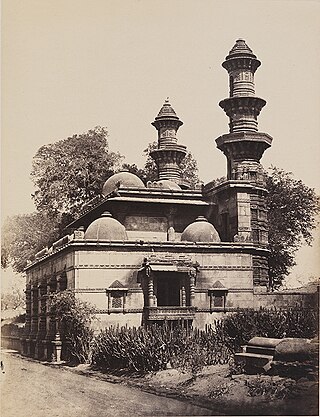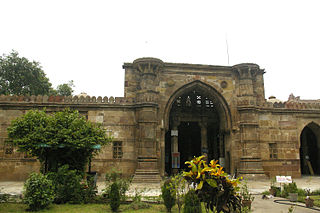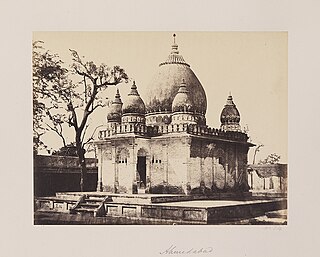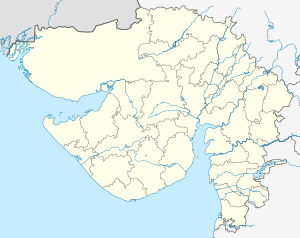
Ahmedabad is the most populous city in the Indian state of Gujarat. It is the administrative headquarters of the Ahmedabad district and the seat of the Gujarat High Court. Ahmedabad's population of 5,570,585 makes it the fifth-most populous city in India, and the encompassing urban agglomeration population estimated at 6,357,693 is the seventh-most populous in India. Ahmedabad is located near the banks of the Sabarmati River, 25 km (16 mi) from the capital of Gujarat, Gandhinagar, also known as its twin city.

The Historic City of Ahmadabad or Old Ahmedabad, the walled city of Ahmedabad in India, was founded by Ahmad Shah I of the Gujarat Sultanate in 1411. It remained the capital of the state of Gujarat for six centuries and later became the important political and commercial centre of Gujarat. Today, despite having become crowded and dilapidated, it still serves as the symbolic heart of metropolitan Ahmedabad. It was inscribed as the World Heritage City by UNESCO in July 2017.
Dholka is a city and municipality in the Ahmedabad District of the Indian state of Gujarat. It is the headquarters of Dholka Taluka, and is 48 km by road via National Highway 8A southwest of the city of Ahmedabad. Dholka has an average elevation of 17 metres (56 ft).

Mughal architecture is the type of Indo-Islamic architecture developed by the Mughals in the 16th, 17th and 18th centuries throughout the ever-changing extent of their empire in the Indian subcontinent. It developed from the architectural styles of earlier Muslim dynasties in India and from Iranian and Central Asian architectural traditions, particularly Timurid architecture. It also further incorporated and syncretized influences from wider Indian architecture, especially during the reign of Akbar. Mughal buildings have a uniform pattern of structure and character, including large bulbous domes, slender minarets at the corners, massive halls, large vaulted gateways, and delicate ornamentation; examples of the style can be found in modern-day Afghanistan, Bangladesh, India and Pakistan.

Indo-Islamic architecture is the architecture of the Indian subcontinent produced by and for Islamic patrons and purposes. Despite an initial Arab presence in Sindh, the development of Indo-Islamic architecture began in earnest with the establishment of Delhi as the capital of the Ghurid dynasty in 1193. Succeeding the Ghurids was the Delhi Sultanate, a series of Central Asian dynasties that consolidated much of North India, and later the Mughal Empire by the 15th century. Both of these dynasties introduced Islamic architecture and art styles from West Asia into the Indian subcontinent.

Champaner-Pavagadh Archaeological Park, a UNESCO World Heritage Site, is located in Panchmahal district in Gujarat, India. It is located around the historical city of Champaner, a city which was founded by Vanraj Chavda, the most prominent king of the Chavda Dynasty, in the eighth century. He named it after the name of his friend and general Champa, also known later as Champaraj. The heritage site is studded with forts with bastions starting from the hills of Pavagadh, and extending into the city of Champaner. The park's landscape includes archaeological, historic and living cultural heritage monuments such as chalcolithic sites, a hill fortress of an early Hindu capital, and remains of the 16th-century capital of the state of Gujarat. There are palaces, entrance gates and arches, mosques, tombs and temples, residential complexes, agricultural structures and water installations such as stepwells and tanks, dating from the eighth to the 14th centuries. The Kalika Mata Temple, located on top of the 800 metres (2,600 ft) high Pavagadh Hill, is an important Hindu shrine in the region, attracting large numbers of pilgrims throughout the year.

The Gujarat Sultanate, or the Sultanate of Guzerat, was a late medieval Indian kingdom established in the early 15th century in Western India, primarily in the present-day state of Gujarat, India. The kingdom was founded by Muzaffar Shah I who was appointed as Tughlaq governor of Gujarat after the death of his father in 1371. Following Timur's invasion of the Delhi Sultanate, Delhi was devastated and its rule weakened considerably, so he declared himself independent in 1394, and formally established the Sultanate. The next sultan, his grandson Ahmad Shah I moved the capital to Ahmedabad in 1411. His successor Muhammad Shah II subdued most Rajput chieftains. The prosperity of the sultanate reached its zenith during the rule of Mahmud Begada. He also subdued most Gujarati Rajput chieftains and built a navy off the coast of Diu. In 1509, the Portuguese empire wrested Diu from the Sultanate in the Battle of Diu (1509). The Mughal emperor Humayun attacked Gujarat in 1535 and briefly occupied it, during which Bombay, Bassein & Daman would become a Portuguese colony, thereafter Bahadur Shah was killed by the Portuguese while making a deal in 1537. The end of the sultanate came in 1573, when Akbar annexed Sultanate of Guzerat into his empire. The last ruler Muzaffar Shah III was taken a prisoner to Agra. In 1583, he escaped from the prison and with the help of the nobles succeeded to regain the throne for a short period before being defeated by Akbar's minister Abdul Rahim Khan-i-Khanan.
Pakistani architecture is intertwined with the architecture of the broader Indian subcontinent. The major architectural styles popular in the past were Temple, Indo-Islamic, Mughal and Indo-Saracenic architecture, all of which have many regional varieties. With the beginning of the Indus civilization around the middle of the 3rd millennium BC, for the first time in the area which encompasses today's Pakistan an advanced urban culture developed with large structural facilities, some of which survive to this day. This was followed by the Gandhara style of Buddhist architecture that borrowed elements from Ancient Greece. These remnants are visible in the Gandhara capital of Taxila.

Sarkhej Roza is a mosque and tomb complex located in the village of Makarba, 7 km south-west of Ahmedabad in Gujarat state, India.

Jama Masjid, also known as Jumah Mosque or Jami' Masjid, is a mosque in Ahmedabad, and was built in 1424 during the reign of Ahmad Shah I. The inscription on the central mihrab commemorates the inauguration of the mosque on the 1st Safar A.H. 827 or January 4, 1424 A.D. by Sultan Ahmad Shah I. The mosque lies in the old walled city, and it is situated outside Bhadra Fort area. The old walled city is divided into separate quarters or pols, and the Jami' Masjid is found on the Gandhi Road. Along the south side of the road, the mosque is a short distance beyond the Teen Darwaza or Tripolia Gate.

The Muhafiz Khan Mosque is a fifteenth-century mosque located in the city of Ahmedabad in the Indian state of Gujarat. It is considered to be one of the more exceptional structures in the city. The mosque was constructed in 1465 by Jamail-ud-Din Muhafiz Khan during the reign of Mahmud Shah I (1458-1511), and is considered to be an excellent example of Mughal architecture. It is named for the governor of the region at that time. The mosque is a protected building under the auspices of the Archaeological Survey of India.

Ahmad Shah's Mosque, also known as Shahi Jam-e-Masjid or Juni Juma Masjid is the oldest mosque of Ahmedabad, India.

Miya Khan Chishti's Mosque and Tomb is a medieval mosque and tomb complex on the bank of Sabarmati river in Shahibaug area of Ahmedabad, India.

Malik Alam's Mosque, also known as Peer Kamaal's Mosque, is a medieval mosque in the Shah Alam area of Ahmedabad, India.

Shah-e-Alam's Tomb and Mosque, also known as Rasulabad Dargah or Shah Alam no Rozo, is a medieval mosque and tomb complex (Roza) in Shah Alam area of Ahmedabad, India.

Jethabhai's Stepwell or Jethabhai ni Vav, is a stepwell in Isanpur area of Ahmedabad, Gujarat, India. It was situated near sha e Alam and one of the heritage stepwells in Ahmedabad.

Sardar Khan's Roza or Nawab Sardar Khan's Mosque and Tomb, is a mosque and tomb complex in Jamalpur area of Ahmedabad, India.

Adhai Din Ka Jhonpra is a historical mosque in the city of Ajmer in Rajasthan, India. It is one of the oldest mosques in India, and the oldest surviving monument in Ajmer.

The tomb of the noble Isa Khan Niazi is located in the Humayun's Tomb complex in Delhi, India. The mausoleum, octagonal in shape and built mainly of red sandstone, was built in 1547–1548 during the reign of Sher Shah Suri. The mosque of Isa Khan is located west of the mausoleum, which along with other buildings form the UNESCO World Heritage Site of Humayun's tomb complex.
The Architecture of Gujarat consists of architecture in the Indian state of Gujarat.





















